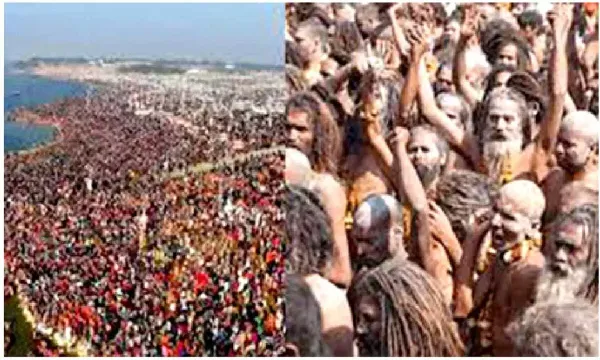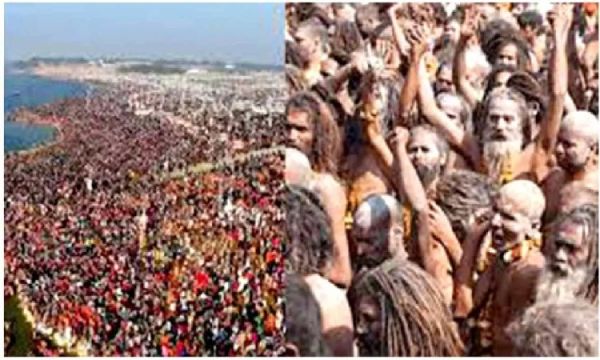
Prime Minister Narendra Modi said, “Our Teertharaj Prayag is made possible by the effect of the Triveni, the glory of Venimadhav, the blessings of Someshwar, the land of penance of Rishi Bhardwaj, the special place of Lord Nagaraj Vasu ji, the immortality of Akshayvat, and the grace of God.”

The Maha Kumbh Mela, a revered assembly that takes place every twelve years from January 13 to February 26, 2025, is more than simply a huge assembly; it is a deep spiritual experience with roots in Hindu mythology. The biggest communal act of faith in the world, this holy event represents self-realization, cleansing, and the never-ending pursuit of enlightenment. Millions of pilgrims, saints, ascetics, and sadhus from all walks of life come together in devotion, representing the very best of human spirituality.
The Kumbh Mela, which is celebrated four times over a 12-year period, alternates between four holy locations in India: Prayagraj at the meeting point of the Ganges, Yamuna, and the legendary Sarasvati; Haridwar on the banks of the Ganges; Ujjain along the Shipra; and Nashik by the Godavari. Hinduism’s holiest season is marked by each event that corresponds with certain astrological positions of the Sun, Moon, and Jupiter. The Kumbh Mela, which combines astronomy, spirituality, rituals, and cultural traditions, is a timeless example of knowledge and faith.
A timeless representation of Sanatan culture, Prayagraj—also known as the “King of Pilgrimages” or Tirthraj—is a city where mythology, spirituality, and history all come together. The confluence of the Ganga, Yamuna, and the ethereal Saraswati rivers makes this holy region a spiritual draw for millions of people looking for redemption and divine favor. At this point, the Maha Kumbh becomes a heavenly voyage—a “triveni” of devotion, spirituality, and meditation.
The holy Baba Loknath Mahadev temple in the busy Loknath neighborhood is one of Prayagraj’s spiritual treasures. Baba Loknath’s temple is immersed in the echoes of eternal devotion and is revered as a “pratiroop” (mirror) of Kashi’s Baba Vishwanath. The Skanda Purana and Mahabharata both make reference to this self-manifested Shiva Linga, highlighting its long history. Thousands of pilgrims will assemble at this hallowed location to experience the divine during the big Maha Kumbh, since many think that seeking Baba Loknath’s blessings will ease worldly hardships. The temple’s connections to notable people like Madan Mohan Malviya further enhance its cultural heritage. The colorful tapestry of Prayagraj’s spiritual devotion is further enhanced by its famous Shiv Barat procession on Shivratri and lively Holi festivities. Baba Loknath’s temple will surely become a major attraction for devotees from all over the world as the city gets ready for Maha Kumbh.
The spiritual metropolis of Maha Kumbh’s Akhara district is alive with devotion as saints and Naga ascetics gather there to meditate, conduct rituals, and exchange knowledge. The tales of Mahant Tara Giri and Mahant Shravan Giri stand out among them for their distinct appeal. Their deep affection for their dogs, Lali and Soma, respectively, exemplifies the altruistic spirit of Sanatan Dharma, which holds that all living things are divine. These saints, who have given up material relationships, develop close relationships with their pets and exemplify the values of unconditional love and ahimsa (non-violence). These stories highlight the Maha Kumbh’s inclusiveness and humanize the austere lifestyles of ascetics by equating spirituality with life’s little pleasures.
Prayagraj’s spiritual appeal is further enhanced by the Maharishi Durvasa Ashram, which is situated in the serene Jhunsi area. Stories of divine penance and redemption may be found at this ancient sanctuary, which is linked to the renowned sage Maharishi Durvasa. Due to his intensive concentration, Maharishi Durvasa is supposed to have placated Lord Shiva, who subsequently protected him from the anger of Lord Vishnu’s Sudarshan Chakra. Devotees seeking “abhaydaan” (freedom from fear) continue to find hope in the Shivling established by the guru. The ashram has been extensively restored in anticipation of Maha Kumbh, and pilgrims are welcome to enter its sanctity via its red sandstone gates and improved amenities. It acts as a reminder of Prayagraj’s enduring connection to mythology and spirituality.
A four-dimensional festival, Kumbh is characterized as an economic phenomenon, a spiritual journey, a logistical miracle, and a symbol of world unification. The idea of Kalpvas, where people disconnect from the fleeting digital world and embrace life’s ultimate truths, perfectly captures the transformational potential of the Maha Kumbh. The Maha Kumbh is a celebration regulated by the divine constitution, not just an occasion. Its essence is found in the satsang of saints and sages, where Sanatan Vedic Hinduism’s ideals are upheld and dharma and commerce coexist.
In 2025, millions of devotees will be able to visit the holy sands of Sangam, and the Maha Kumbh is expected to be a unique spiritual journey. It is a call to rediscover one’s heritage, absorb the ageless teachings of Sanatan Dharma, and take part in a celebration that goes beyond the ordinary. The Maha Kumbh is a tapestry of faith, devotion, and transcendence, encompassing everything from the marvels of life itself to the supernatural blessings of Baba Loknath and the legendary heritage of Maharishi Durvasa.